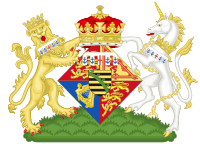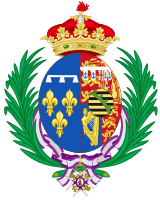Princess Beatrice of Saxe-Coburg and Gotha
| Princess Beatrice | |||||
|---|---|---|---|---|---|
|
Infanta of Spain Duchess of Galliera | |||||
 | |||||
| Born |
20 April 1884 Eastwell Park, Kent, England | ||||
| Died |
13 July 1966 (aged 82) El Botánico, Sanlúcar de Barrameda, Spain | ||||
| Spouse | Infante Alfonso, Duke of Galliera | ||||
| Issue |
Infante Alvaro, Duke of Galliera Infante Alonso Infante Ataúlfo | ||||
| |||||
| House | Saxe-Coburg and Gotha | ||||
| Father | Alfred, Duke of Saxe-Coburg and Gotha | ||||
| Mother | Maria Alexandrovna of Russia | ||||
Princess Beatrice of Saxe-Coburg and Gotha (Beatrice Leopoldine Victoria; 20 April 1884 – 13 July 1966) was a member of the British Royal Family, a granddaughter of Queen Victoria. She later married into the Spanish Royal Family, and was the wife of Alfonso de Orleans y Borbón, Infante of Spain, a first cousin of Alfonso XIII of Spain. She was called "Baby Bee" by her family.[1]
Early life
Princess Beatrice was born on 20 April 1884 at Eastwell Park, Kent. Her father was the Prince Alfred, Duke of Edinburgh, the second eldest son of Queen Victoria and The Prince Consort. Her mother was Grand Duchess Marie Alexandrovna of Russia, the only surviving daughter of Alexander II of Russia and Princess Marie of Hesse and by Rhine.
She was baptised at Eastwell House on 17 May 1884 by the Revd William Lloyd (her father's chaplain); among her godparents were her paternal aunt The Princess Beatrice.[2]
Beatrice spent much of her early years in Malta, where her father was serving in the Royal Navy. She was a bridesmaid at the wedding of the Duke and Duchess of York (the future King George V and Queen Mary) on 6 July 1893.[3]
On the death of Prince Alfred's uncle, Ernst II, Duke of Saxe-Coburg and Gotha, on 22 August 1893, the duchy fell to the Duke of Edinburgh, since the Prince of Wales, the Duke's elder brother and future King Edward VII, had renounced his right to the succession.
The Duke and Duchess along with their five surviving children travelled to Coburg to take up residence shortly afterwards.
Marriage prospects
In 1902, Princess Beatrice had a romance with Russian Grand Duke Michael, the younger brother of Tsar Nicholas II, and at that time the heir presumptive to the Imperial Throne. She began receiving letters from him in September 1902 and, although he was a Russian Grand Duke and she now a German Princess, they corresponded in English, and he nicknamed her "Sima".[4] However she was prevented from marrying the Grand Duke as the Russian Orthodox Church forbade the marriage of first cousins. Although such marriages had been allowed previously in the House of Romanov (Grand Duchess Catherine Pavlovna, whose hand was denied to Napoleon I, was twice allowed to wed first cousins; her descendants became the Russian branch of the Dukes of Oldenburg), the devout Nicholas II, the official head of Russia's church, refused to bend the rules for his brother's sake.[4]
In November 1903, Michael wrote to Beatrice telling her that he could not marry her. The situation was aggravated by a letter Beatrice then received from her elder sister Victoria Melita ("Ducky"), in which Michael was blamed for having callously initiated the doomed romance (when, a couple of years later Ducky, having divorced her first cousin Ernest Louis, Grand Duke of Hesse, was told that remarriage to another first cousin, Grand Duke Cyril Vladimirovich Romanov, would likewise be forbidden by the Tsar, she refused to take no for an answer; the couple eloped into exile). [4] The humiliated Beatrice was sent to Egypt to recover from heartbreak, but pined and wrote reproachful letters to Michael until 1905.[4]
Beatrice was then rumoured to be going to marry Alfonso XIII of Spain, but this proved to be a false rumour also as he married her cousin Victoria Eugenie of Battenberg in 1906. It was at their wedding that Beatrice met a cousin of King Alfonso, Alfonso de Orleans y Borbón (12 November 1886 Madrid, Spain–10 August 1975), Infante of Spain, 5th Duke of Galliera. The Spanish government objected to an infante's proposed match with a British Princess who, unlike Queen Victoria Eugenie, had not agreed to convert to Roman Catholicism: the King was obliged to make clear that, should the wedding take place, the couple would have to live in exile.
Nonetheless, Beatrice and Alfonso married in a Roman Catholic and Lutheran ceremony at Coburg on 15 July 1909. The couple settled in Coburg, until, in 1912, Alfonso and Beatrice were allowed to return to Spain, and his rank of Infante was restored.
In August 1913 Beatrice was received into the Roman Catholic Church.[5]
Scandal and Exile
During King Alfonso XIII's unhappy marriage, he had numerous affairs and dalliances, some of which produced illegitimate children. He allegedly also made advances toward Princess Beatrice, which she rebuffed. The king thus expelled her and her husband from Spain, under the pretext of sending Infante Alfonso on a mission to Switzerland. At the same time, the king's circle of friends, who despised both Beatrice and the queen, Ena, started to spread malicious rumours, saying that Beatrice had been expelled because of her bad behaviour, which was not true.
The couple had three sons:
- Alvaro Antonio Fernando Carlos Felipe (20 April 1910 Coburg, Germany–22 August 1997)
- Alonso María Cristino Justo (28 May 1912 Madrid, Spain–18 November 1936 Spain); Killed in action during the Spanish Civil War
- Ataúlfo Alejandro Isabelo Carlos (20 October 1913 Madrid, Spain–4 October 1974 Málaga, Spain)
Civil War
The family moved to England, where the three sons were educated at Winchester College. The Spanish Royal Family eventually relented, and Beatrice and her family were allowed to return to Spain where they established their home at an estate in Sanlúcar de Barrameda.
The 1930s were an unhappy time for the family, as the collapse of the Spanish monarchy and the subsequent civil war led to the loss of much of the family's wealth. After the establishment of the Second Spanish Republic in 1931, King Alfonso and his family fled into exile in Italy. In the years that followed, the political situation in Spain worsened as various groups wrestled for power. By the late-1930s, the conflicts had erupted into all-out civil war. Beatrice and Alfonso lost their estate during the war, and the couple's middle son, Alfonso, was killed fighting the Republicans.
Later life
Beatrice died at her estate of El Botánico in Sanlúcar de Barrameda on 13 July 1966. Her husband survived her by nine years. Their son Ataulfo died, unmarried, in 1974. Their only grandchildren are the children of Prince Alvaro.
At the time of her death, Beatrice was the last surviving child of Prince Alfred and Grand Duchess Maria Alexandrovna.
Titles, styles, honours and arms
Titles and styles
- 20 April 1884 – 22 August 1893: Her Royal Highness Princess Beatrice of Edinburgh[6]
- 22 August 1893 – 15 July 1909: Her Royal Highness Princess Beatrice of Saxe-Coburg and Gotha and Edinburgh
- 15 July 1909 – 24 December 1930[7]: Her Royal Highness Infanta Alfonso de Orleans y Borbón, Princess of Saxe-Coburg and Gotha and Edinburgh
- 24 December 1930 – 14 July 1937[8]: Her Royal Highness The Duchess of Galliera, Princess of Saxe-Coburg and Gotha and Edinburgh
- 14 July 1937 – 13 July 1966: Her Royal Highness Infanta Alfonso de Orleans y Borbón, Princess of Saxe-Coburg and Gotha and Edinburgh
|
British arms
Beatrice's arms in Britain were the royal arms, with an inescutcheon of the shield of Saxony, differenced with a label argent of five points, the central bearing a cross gules, the four others anchors azure. In 1917, the inescutcheon was dropped by royal warrant from George V.[9] This did not affect her Saxon arms.
Honours
-
 Member Second Class of the Royal Order of Victoria and Albert
Member Second Class of the Royal Order of Victoria and Albert -
 Dame of the Royal Order of Queen Maria Luisa
Dame of the Royal Order of Queen Maria Luisa - Dame Grand Cross of Justice of the Sacred Military Constantinian Order of Saint George[10]
Ancestry
Notes and sources
- ↑ Eilers, Marlene. Queen Victoria's Descendants. Rosvall Royal Books, Falkoping, Sweden, 1997. p. 85. ISBN 91-630-5964-9
- ↑ Yvonne's Royalty Home Page – Royal Christenings
- ↑ "The Duke and Duchess of York and Bridesmaids". National Portrait Gallery, London.
- 1 2 3 4 Crawford, Rosemary & Donald. "An Innocent Abroad," Michael and Natasha, pp. 50–52. New York: Scribner, 1997; ISBN 0-684-83430-8
- ↑ "Princess to Enter Catholic Church", The New York Times (15 August 1913): p. 4
- ↑ As a granddaughter of the British monarch in the male line, Beatrice held the title of Princess of the United Kingdom of Great Britain and Ireland with the style Her Royal Highness.
- ↑ Lundy, Darryl. "p. 10446 § 104454 – Antonio, 4th Duke of Galliera". thepeerage.com.
- ↑ Lundy, Darryl. "p. 10446 § 104453 – Alfonso, 5th Duke of Galliera". thepeerage.com.
- ↑ Heraldica – British Royalty Cadency
- ↑ Constantinian Order
.svg.png)


